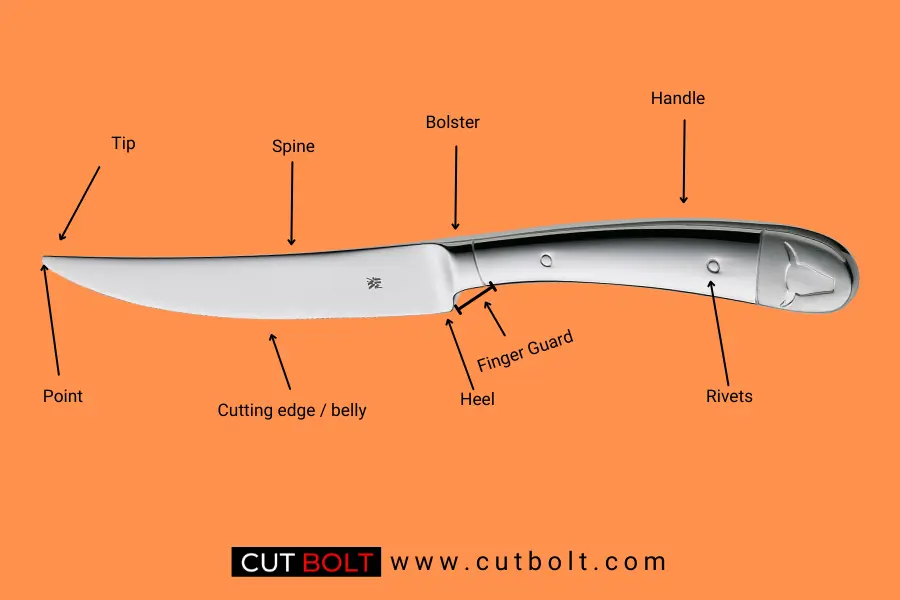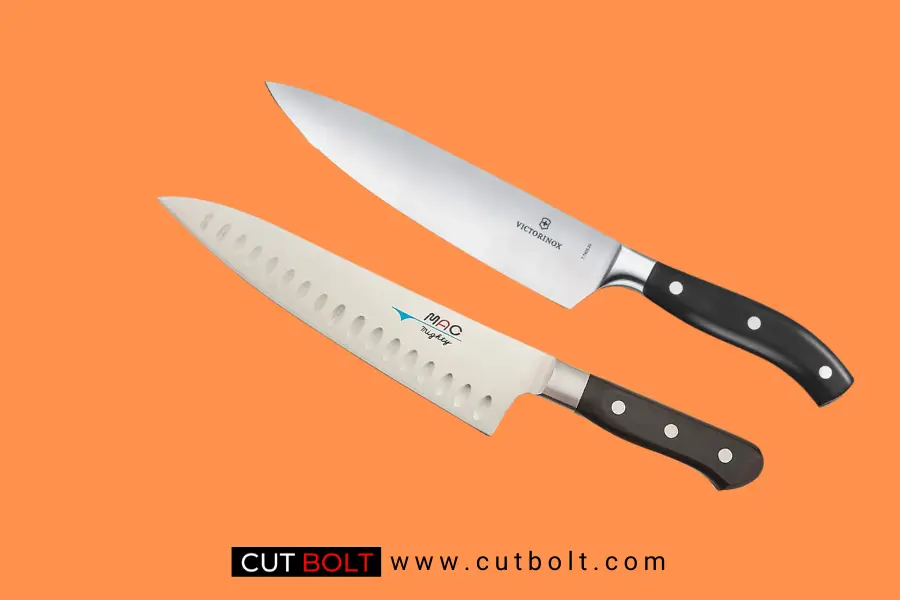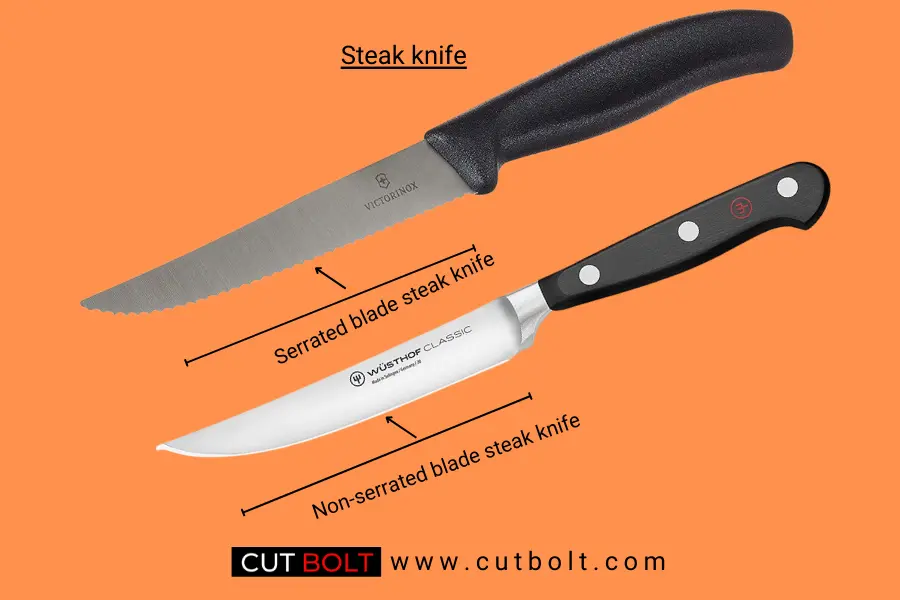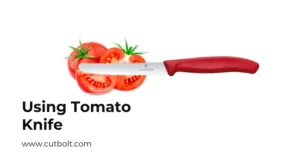A kitchen is not complete without a good set of knives. Whether you’re a professional chef or a home cook, having the right type of knife is essential for preparing and serving food.
In this article, we’ll be taking a closer look at two of the most commonly used knives in the kitchen: the chef knife and the steak knife. We’ll explore the differences between these two types of knives, their advantages and disadvantages, and when it’s appropriate to use each one.
Before we go deeper into the discussion, here is a quick reference if you are looking for a sneak peek of chef knife vs steak knife:
| Attributes | Steak Knife | Chef Knife |
|---|---|---|
| Blade Shape | Straight and pointed tip | Curved and rounded tip |
| Blade Length | Typically 4-5 inches | Typically 6-14 inches |
| Blade Thickness | Thinner and more flexible | Thicker and less flexible |
| Blade Material | High-carbon stainless steel or serrated edge | High-carbon stainless steel or Damascus steel |
| Purpose | Cutting through cooked meat | General purpose cutting, chopping, and slicing of ingredients |
| Handle | Often wooden or plastic and ergonomic | Wide variety of materials and designs |
| Maintenance | Easy to clean and maintain due to simple design | Requires regular sharpening and maintenance |
| Cost | Generally less expensive than chef knives | Range from affordable to very expensive depending on quality |
Note: This table is for general reference only, as there may be variations in blade design, length, sharpness, and other criteria among different brands and models of chef and steak knives.
Related: Butter knife vs Dinner knife

Chef Knives
Definition and Description of Chef Knives
A chef knife is a versatile kitchen knife that is used for a wide variety of tasks. It has a broad blade that curves upwards towards the tip, allowing the user to rock the knife back and forth on the cutting board to quickly and efficiently chop, slice, and dice food.
Features and Design of Chef Knives
A typical chef knife has a blade that is between 8 and 10 inches long and about 1.5 inches wide.
The blade is made from high-quality steel, which allows it to maintain a sharp edge even with frequent use.
The handle is typically made from wood, plastic, or metal, and is designed to provide a comfortable and secure grip.

Advantages and Disadvantages of Using Chef Knives
One of the biggest advantages of using a chef knife is its versatility. It can be used for a wide variety of tasks, from chopping vegetables to slicing meat. Chef knives are also designed to be ergonomic and comfortable to use, which makes them ideal for extended periods of cutting and chopping.
One potential disadvantage of using a chef knife is that it can be difficult to control when performing precision cuts. Its large size and curved blade make it better suited for rough chopping and slicing than for intricate tasks like peeling and trimming.
Here are some advantages of using a chef knife:
- Versatility: A chef knife is a multi-purpose tool that can be used for a variety of tasks, such as chopping, slicing, dicing, and mincing. It can be used on a variety of ingredients, including meats, vegetables, fruits, and herbs.
- Efficiency: The large blade of a chef knife allows for efficient cutting and chopping, making food preparation faster and easier.
- Precision: Chef knives are designed to be precise, with a sharp blade that can make clean cuts through even the toughest ingredients. This allows for precise control over the size and shape of the cuts.
- Comfort: Chef knives are designed to be comfortable to use, with an ergonomic handle that fits comfortably in the hand and reduces strain on the wrist and fingers.
- Durability: Chef knives are often made from high-quality materials that are designed to last a long time and withstand regular use. This makes them a good investment for home cooks and professional chefs alike.
- Safety: The large blade of a chef knife can be intimidating, but when used correctly, it can actually be safer than using smaller knives. With a chef knife, you can keep your fingers away from the blade and use a rocking motion to make cuts.
- Presentation: Using a chef knife to prepare ingredients can add a touch of professionalism to your dishes, making them look and taste better.
- Maintenance: Chef knives require regular maintenance, such as sharpening and cleaning, but with proper care, they can last a lifetime.
Common Uses for Chef Knives in the Kitchen
Chef knives are most commonly used for tasks like chopping vegetables, slicing meat, and mincing garlic and herbs. They are also great for chopping nuts, slicing cheese, and even carving fruits and vegetables into decorative shapes.
Steak Knives
Definition and Description of Steak Knives
A steak knife is a type of table knife that is used specifically for cutting meat, particularly steak. It typically has a sharp, serrated edge that makes it easy to cut through even the toughest cuts of meat.
Features and Design of Steak Knives
A typical steak knife has a blade that is between 4 and 5 inches long and about 1 inch wide. The blade is usually serrated, which makes it easier to cut through meat without tearing or shredding it. The handle is typically made from wood, plastic, or metal, and is designed to provide a comfortable and secure grip.

Advantages and Disadvantages of Using Steak Knives
One of the biggest advantages of using a steak knife is its ability to cut through meat cleanly and easily. Its serrated edge allows it to slice through even the toughest cuts of meat without tearing or shredding it.
One potential disadvantage of using a steak knife is that it is not as versatile as a chef knife. It is designed specifically for cutting meat, and may not be as effective for other tasks like chopping vegetables or slicing bread.
Here are some advantages of using a steak knife:
- Precision: Steak knives have sharp, serrated edges that allow for precise cuts through tough meats, ensuring that you can enjoy each bite without struggling to chew or tear the meat.
- Clean Cuts: Unlike other knives that can tear or shred meat, steak knives make clean cuts that leave the meat’s juices and flavors intact, making your meal more enjoyable.
- Versatility: Steak knives are not just for steak. They can also be used to cut through other meats, such as chicken or pork, as well as vegetables and fruits.
- Durability: Steak knives are often made from high-quality materials that are designed to withstand regular use and stay sharp for a long time.
- Presentation: Using a steak knife at the dinner table adds a touch of elegance and sophistication to your meal. They are perfect for formal occasions, dinner parties, or any time you want to impress your guests.
- Convenience: Having a set of steak knives on hand means that you don’t have to struggle with dull or inappropriate knives when cutting through meats at the dinner table.
- Comfort: Steak knives are designed with ergonomics in mind, providing a comfortable grip and reducing the strain on your hand and wrist when cutting through meats.
- Maintenance: Unlike other knives that require regular sharpening, steak knives can be easily maintained by hand washing and occasional sharpening.
Common Uses for Steak Knives in the Kitchen
Steak knives are most commonly used for cutting meat, particularly steak. They are also great for cutting other types of meat like pork and chicken, as well as for slicing bread and other baked goods.
We have discussed about differences between Chef knife and Santoku knife which may be helpful for you to learn about their uses.
Comparison: Steak knife vs Chef knife
Now that we’ve looked at the features and advantages of both chef knives and steak knives, let’s compare them more directly.

Differences in Blade Design, Length, and Sharpness
One of the biggest differences between chef knives and steak knives is their blade design. Chef knives have a broad, curved blade that is designed for chopping, slicing, and dicing a wide variety of foods. Steak knives, on the other hand, have a narrower, serrated blade that is designed specifically for cutting meat.
In terms of length, chef knives are typically longer than steak knives. Chef knives can range from 8 to 10 inches in length, while steak knives are usually around 4 to 5 inches long.
When it comes to sharpness, both chef knives and steak knives should be kept sharp to ensure efficient cutting. However, chef knives typically require more frequent sharpening due to their wider blades and greater usage.
Factors to Consider When Choosing Between Chef Knives and Steak Knives
When deciding whether to use a chef knife or a steak knife, there are a few factors to consider.
Blade Design:
Chef knives have wide, curved blades that are perfect for chopping, slicing, and dicing vegetables, meats, and fruits. The blade is usually between 8 to 10 inches long and made from high-quality stainless steel. The blade design also features a sharp tip that can be used for piercing.
Steak knives, on the other hand, have a pointed, straight blade with a sharp edge. This design allows for precise cutting of meats, particularly steak, and other foods that require a sharp edge. The blade is typically between 4 to 6 inches long and made from high-quality stainless steel.
Length and Sharpness:
As mentioned, chef knives are typically longer than steak knives. The length of a chef knife allows for better control and precision when cutting through large vegetables and meats. They’re also sharper than steak knives, allowing for a smooth cutting experience with minimal effort.
Steak knives are shorter than chef knives, but their sharpness is unmatched. They’re designed to cut through meat with ease, without tearing or shredding the meat fibers.
Finally, consider your personal preferences and comfort level. If you’re more comfortable using a chef knife, even for cutting meat, go for it! However, if you prefer the feel of a steak knife in your hand, use that instead.
Real-World Examples:
Let’s say you’re preparing a stir-fried dish with vegetables and meat. A chef’s knife would be the perfect tool to chop the vegetables and slice the meat into thin strips. Now, let’s say you’re serving a juicy, tender steak. A steak knife would be ideal for cutting the steak into bite-size pieces, without tearing or shredding the meat.

Conclusion: Chef Knife vs Steak Knife
In conclusion, both chef knives and steak knives serve different purposes in the kitchen. Chef knives are perfect for cutting vegetables, meats, and fruits, while steak knives are ideal for cutting meat without damaging its texture. Having both types of knives in your kitchen is essential for preparing different types of meals.
When choosing the right knife for a specific task, consider the food you’re preparing and its texture. Chef knives are ideal for cutting through tough meats and vegetables, while steak knives are perfect for cutting through soft, tender meats. Choose the right tool for the job, and your meal preparation will be a breeze.


